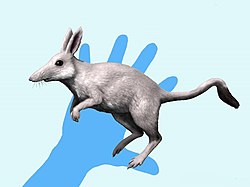Description
This genus is mainly known from cranial materials, and was related to the genus Borhyaena . Its skull had a short snout, strong and large canines, a particularly deep mandible, and molars with reduced talonids and protocones. It also had a swollen cranial vault, and a well-developed temporal fossa. Australohyaena was one of the largest predators of its environment, weighing up to 70 kilograms (150 lb). [1]
Classification
This genus was until recently only known from isolated teeth, described in 1894 by Florentino Ameghino as Borhyaena antiqua. These teeth were later attributed to the genus Pharsophorus . In 2014, the discovery of a complete skull allowed its identification as a new genus, Australohyaena.
Australohyaena is a member of the order Sparassodonta, a group of South American mammals similar to marsupials, whose appearance vaguely resembled placental carnivores from the rest of the world.
This page is based on this
Wikipedia article Text is available under the
CC BY-SA 4.0 license; additional terms may apply.
Images, videos and audio are available under their respective licenses.




